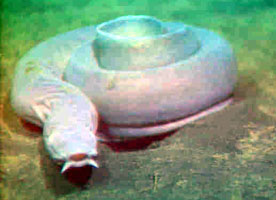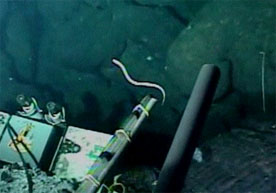Slurp gun used to capture fish from deep sea hydrothermal vent
Slurp gun used to capture hermaphrodite from hydrothermal vent
mongabay.com
February 15, 2007
Researchers used an “Alvin Slurp Gun” to capture a hagfish from a deep sea hydrothermal vent. It is the first time that a member of the jawless fishes (agnathans) has been captured from a hydrothermal vent site. The results are published in the current edition of the journal Biology Bulletin.
Peter R. Møller from the Zoological Museum at the University of Copenhagen and W. Joe Jones of the Monterey Bay Aquarium Research Institute (MBARI), captured the specimen at a depth of 2211 meters during the Easter Microplate expedition, 12 March—6 April 2005 to the East Pacific Rise, a region of sea floor spreading under the eastern Pacific Ocean (37 degrees South, 110 degrees West, several hundred miles from Easter Island). The bright pink hagfish was swimming about a meter off the ocean floor in the vent. Later analysis concluded it was a species new to science. It has since been named Eptatretus strickrotti.
According to Dr. Jones, the National Science Foundation-funded expedition was led by Dr. Bob Vrijenhoek (MBARI) and Dr. Cindy Van Dover (Duke Marine Lab). The expedition used the Alvin, a deep-ocean research submersible owned by the United States Navy and operated by the Woods Hole Oceanographic Institution, to collect deep-sea specimen. Jones notes that on the previous Alvin dive, “we collected the infamous yeti crab (Kiwa hirsuta).”
Jones says that the new hagfish was captured using the Alvin slurp gun.
 Pacific hagfish, photographed on July 7, 2001 during expedition by the National Oceanic and Atmospheric Administration (NOAA). A different species was recently discovered in the South Pacific. Courtesy of the National Oceanic and Atmospheric Administration.
|
“The Alvin slurp gun is a vacuum canister attached to the front of Alvin that is connected to a Tygon tube position in the front of Alvin,” he explained. “The specimens are suctioned through the tube and stored in a canister on the front of Alvin. It is usually used for collecting small sessile animals — not moving fish.”
Video from the capture is available from the Woods Hole Oceanographic Institution
Hagfish are long, worm-like fish that “can exude copious quantities of a sticky slime or mucus,” according to Wikipedia. They are hermaphroditic, with both ovaries and testes, but Dr. Jones, noted “the specimen is too small to sex.”
Hydrothermal vents — fissures in the Earth’s surface from which geothermally heated water emerges — are generally found in volcanically active parts of the seafloor. They are biologically productive relative to other seafloor areas and commonly support “extremeophile” species tolerant of high water temperatures and communities based around chemicals rather than sunlight.
Citation: PETER R. MØLLER,* AND W. JOE JONES (2007). Eptatretus strickrotti n. sp. (Myxinidae): First Hagfish Captured From a Hydrothermal Vent. Biology Bulletin 212: 55—66. (February 2007)
This article uses information from “Eptatretus strickrotti n. sp. (Myxinidae): First Hagfish Captured From a Hydrothermal Vent” and Wikipedia.
